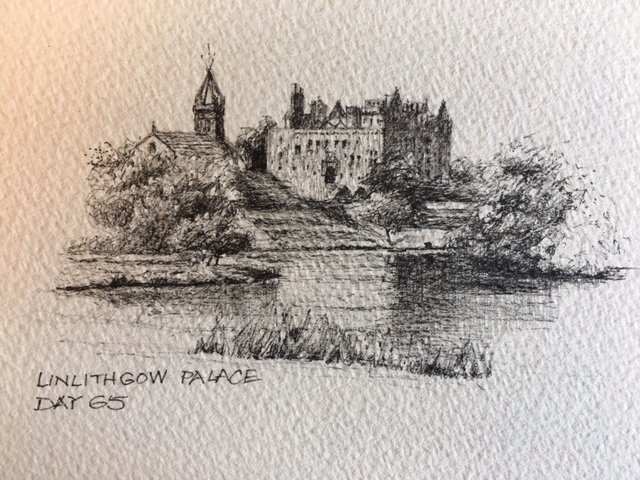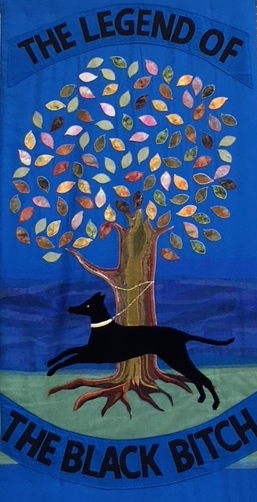From: West Linton to Linlithgow
Distance: 12m / 19.3km
Cumulated distance: 849m / 1366km
Percentage completed: 71.8

I didn’t have great expectations for this morning’s walk. In order to hook up with the Union Canal, I needed to walk along a B road for several miles and wrongly assumed it would be dull. It was a busy road but there was plenty of interest along the way. The village of Ecclesmachan was an unexpected treat. Ecclesmachan means Church of St Machan and in the graveyard of the church I found several beautifully carved headstones. The lighting wasn’t the best but here are a couple to give you a flavour ..

A man sowing seed between two winged souls and crossed bones, indicating mortality.

A winged soul above two skulls, crossed bones and an hour-glass .. once again reminding the viewer that life is all too brief

More crossed bones, hour glasses, a heart and skulls but this time with the carving of a plough beneath .. the grave of a farmer.

More timely emblems of mortality.
The gravestone above was particularly interesting. The skull and crossed bones remind that death comes to everyone, as indicated by the words written on the stone: ‘Memento Mori’, meaning, ‘Remember that you must die’. There’s also a rare winged hourglass, signifying that life both trickles and flies.
And my favourite, beautifully designed and carved Victorian stone was one dedicated to Revd George D Shepherd, who died at the tender age of 26 in 1899. It read: ‘A brilliant student, an ardent and unselfish Christian, already promoting his missions brightening human lives and modestly leading others … Erected by relatives and neighbours in loving remembrance of his beautiful life’.

Victorian wall stone
Ecclesmachan’s other claim to fame is the bomb hole just outside the village, created during World War II. The intended target was the Forth Bridge but thankfully it was early on in the war and the Luftwaffe was a little short of target practice.
And moving back into the present, away from the bomb crater and the gravestones, the village had beautiful flowers to enjoy for passersby, such as me.

Vibrant rhododendrons

Inventive planting

The wonderfully named Binny Beck
The Union Canal is like many others, in that it enjoyed its heyday in the 19th century but was eclipsed by the advent of the speedier trains. This canal was used to transport mainly coal and lime from Falkirk to Edinburgh. It’s what’s known as a ‘contour canal’, which sticks close to the contour line of the land and avoids costly engineering works, such as tunnels or locks. This gives them their characteristic meandering course and for walkers, a pleasant towpath to follow.

Union Canal
The sun was shining brightly by the time I reached the canal and the reflections were superb.

Canal reflections
Surprisingly, birdlife along the banks was pretty sparse. At one stage however, I had to give as wide a berth as I possibly could to a male swan .. a cob .. sitting on the towpath, protecting his partner .. the pen .. who was nesting close by. Walking past was a pretty hissy affair.

Soon to be parents

Mallard
There was the odd duck and boat but apart from that the star turn was the water itself and the reflections.

The occasional narrowboat ..

.. and the occasional screen-reading teenagers, seemingly oblivious to the beauty around them!
Linlithgow was my stop for the day. The romantic ruined palace there was the birthplace of Mary Queen of Scots in 1542. Her French mama, Marie de Guise, was not only considered a strong and good leader as her regent but she also introduced the Scots to knickers .. the women, not the men of course (as we all know ‘nothing is worn under the kilt’) and she has continued to make herself felt as a spectre around the palace.

Linlithgow Palace
Her daughter, Mary Queen of Scots had a colourful life .. she became queen at 6 days old; survived three marriages; was forced to abdicate in favour of her one year old son, James; spent half her life under arrest in various castles and manor houses around England and finally fell foul of her first cousin once removed, Elizabeth I, who had her head chopped off for allegedly plotting to assassinate her. And her execution was not without drama either. The executioner missed her neck with his first blow and struck the back of her head. The second blow only severed the neck and he was forced to hack through the remaining sinew with his axe. And then, as he held the head aloft declaring, ‘God save the Queen’, the mane of red hair remained in his hand while the head thudded to the floor: the crowd gasped as it was revealed that Mary had been wearing a wig over her very short grey hair. The finale was reached when Mary’s pet dog, a Skye Terrier, emerged from her skirts .. he’d been there the whole time and after the beheading refused to be separated from his mistress. Her body anyway.
The coat of arms for Linlithgow is a testimony to the loyalty of black dogs. It features a female black dog, a black bitch, chained to an oak tree on an island. The story goes that the faithful bitch used to swim out to the island every day to take food to her master, who had been sentenced to starve to death there. When this was discovered she was taken to a different island where she too was chained to a tree and left to die. The townspeople took the animal’s loyalty and bravery as symbolic of their own and even to this day they are known as ‘black bitches’. The local pub named “The Black Bitch” is reputed to be one of Scotland’s oldest pubs.

Appliqueed Black Bitch
Black Dog Tails
Rufus is making a significant difference in young Christian’s life. Rufus is an Australian Autism Assistance dog. “Rufus gives our son independence. He is able to hold on to Rufus and not run away, giving us security and safety.” said mum Carolyne. Please do tap on the link in the picture to read the whole of Rufus and Christian’s story .. it’s amazing.
![]()




Thank you Jules for brightening up my Monday morning. Have a good walk today
Lovely getting your message, Joanne. Thank you. x
Jules – just amazing inspiration, from the walk itself but additionally the daily blogging, photos, facts and drawings…. I don’t know how you fit it all in!! I an really enjoying the journey with you. I know Sophie is so looking forward to joining you very very soon, after her birthday in London, which she tells me she has a long lunch planned, followed by dinner before coming to you the next day!!
Lots of Love and admiration to you
tess xx
Can you sense me blushing! Thank you for your lovely words, Tessa. I’ll be prepared to treat Sophie with kid gloves when she arrives .. or possibly kid socks would be more appropriate! xx
I am so enjoying your story and look forward to clicking on to it each morning! I am Frannie’s mother in law, by the way and live in Dorset.
Your drawings and pictures are stunning and I am learning so much about parts of my country I don’t know at all.
Thank you.
So lovely to hear from you, Mary! Frannie is one of my favourite people and it’s very good to know that you’re keeping her company in following the blog. Thank you!
Your photos today Jules are fabulous – such colours and beauty. And Linlithgow Palace features prominently in my book – in this case, home at the time of Mary Queen of Scots’ grandparents. QF1 beckons tomorrow…but I will look out for your next post just as keenly whereever I am. Lots of love xx
Hope QF1 treated you well and showed you good movies! xx
Hi Jules, I spoke to you briefly when you were on the Drovers road towards Kirknewton (I had the insane looking Boxer dog)
I have to say I’ve been running through the past few days of you blog and actually learned quite a few things about the local area!
Wish you luck for the rest of your travels!
Scott (and Tucker)
How lovely of you to get in touch, Scott .. and Tucker. Lovely to meet you both!
You are doing something very special Jules and for a very special purpose. All your blogs are so wonderfully interesting and I love the way you want to share your days and what you see with others. Walking is so good for the spirit. xx
Couldn’t agree more, Marilyn. Sure you’ll be recognising places in photos over the next couple of weeks, from your own epic journey from 20 years ago. xx
Loved your photos of the canal’s reflections Jules , but your piece on local history today was fascinating.. Always learning so much when reading your blog , like hearing that Marie de Guise introduced lingerie to Scottish women in the 16th century . Amazing fact ! A week today I will be on British soil , so exciting xox
Thank you, my friend .. of course it took a French woman to introduce the Brits to such an elegant, divine piece of clothing! There’ll be lots of similar stories to discover together in a couple of weeks’ time. xx